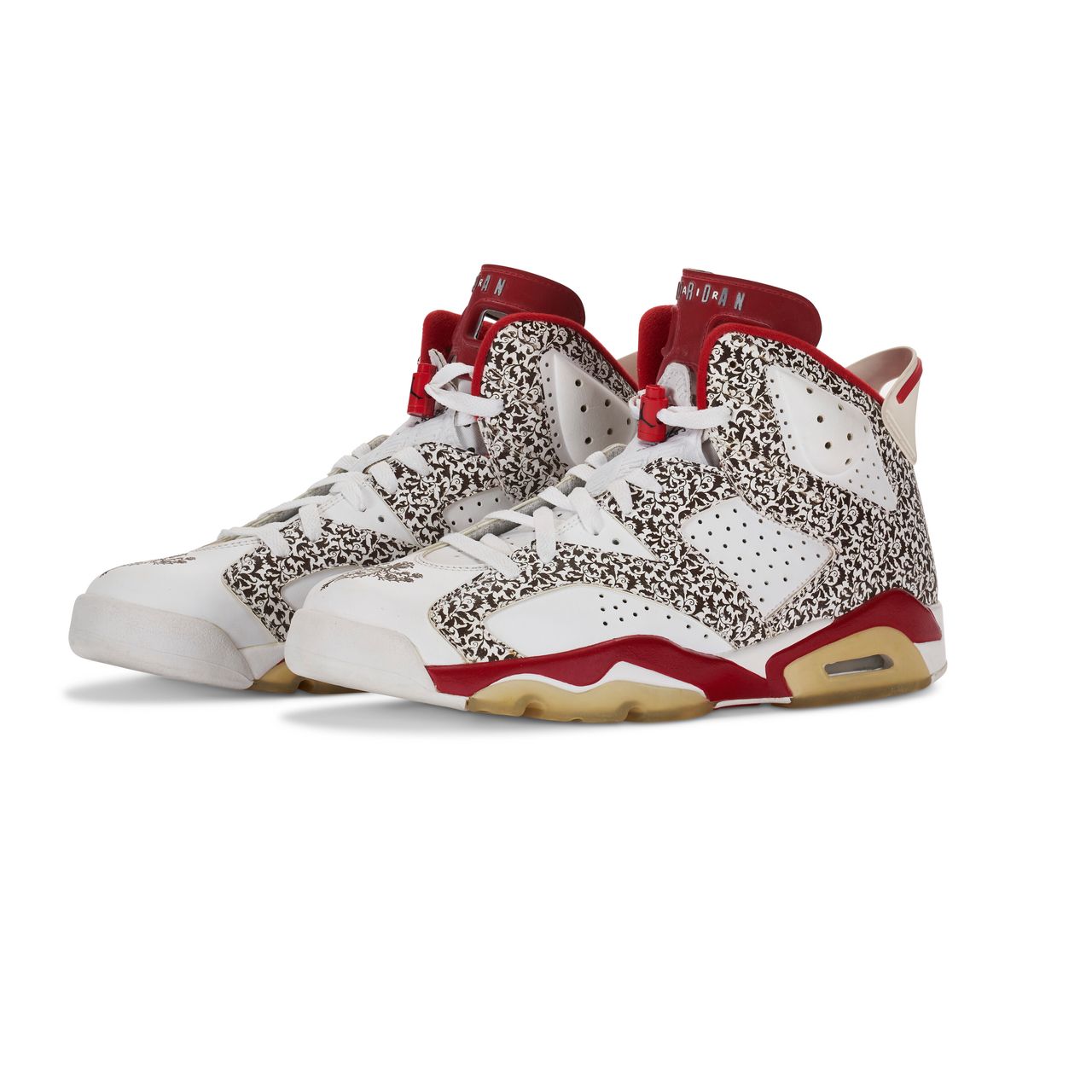Christie’s Dives Deep Into Emerging Collecting Categories—Sneakers and NFTs
Christie’s launched two major initiatives this week in an attempt to cater to younger collectors: Department X, which will focus on streetwear and pop culture, and Christie’s 3.0, a platform to handle NFT sales fully on blockchain.
Department X, launched Monday, will be led by Caitlin Donovan, a founding member and current head of the department of handbags and accessories at Christie’s Americas. She has been working on specialized sales of sneakers, streetwear, and other luxury collectibles over the past three years.
“With exciting sales that will cross several genres of popular culture and collecting–music, fashion, and sports history—I am excited for new and existing clients of Christie’s to embark on this journey with us,” she said in a news release Tuesday.
The department will hold online auctions, with previews in New York, as well as private selling exhibitions throughout the year. The debuting private selling exhibition will showcase two pairs of Nike Air Yeezy sneakers designed by rapper and fashion designer Kanye West.
One pair, the Nike Air Yeezy 1 prototype was the first sneaker West designed with Nike creative director Mark Smith and designer Tiffany Beers. The other pair, the Nike Donda West Air Jordan VI, was designed for West’s mother and never released for public sale.
Christie’s is a latecomer to the emerging category of sneakers and streetwear. Its largest competitor Sotheby’s established a department dedicated to this collecting space–with online sales only–in the first half of 2020. Bonhams has had a department handling auctions, both live and online, of pop culture collectibles, including film, entertainment, music, and sporting memorabilia, since the early 1980s.
On Tuesday, Christie’s launched Christie’s 3.0, a platform to enable NFT sales fully on the Ethereum blockchain network. The marketplace was developed in collaboration with three leading companies in the Web3 community: Manifold, Chainalysis, and Spatial.
The new platform has incorporated compliance and taxation tools and will feature high-quality digital artworks and curated collections, according to Nicole Sales Giles, Christie’s director of digital art sales.
The inaugural sale, running from Sept. 18 through Oct. 11, will feature nine NFTs specifically created by visual artist Diana Sinclair to launch Christie’s 3.0. Estimates range from ETH 4 to 8 (US$5,245 to US$10,489).
Sinclair, 18, was recognized by Fortune as one of the top 50 most influential people in the NFT space. She is the curator behind Digital Diaspora, a Juneteenth exhibition that highlights the work of Black artists and creatives in the NFT community.
Last year, she also collaborated with the estate of Whitney Houston to create a digital video featuring rare archival photos of the late singer that sold for approximately US$1 million.
 Copyright 2020, Dow Jones & Company, Inc. All Rights Reserved Worldwide. LEARN MORE
Copyright 2020, Dow Jones & Company, Inc. All Rights Reserved Worldwide. LEARN MORE
This stylish family home combines a classic palette and finishes with a flexible floorplan
Just 55 minutes from Sydney, make this your creative getaway located in the majestic Hawkesbury region.
As Paris makes its final preparations for the Olympic games, its residents are busy with their own—packing their suitcases, confirming their reservations, and getting out of town.
Worried about the hordes of crowds and overall chaos the Olympics could bring, Parisians are fleeing the city in droves and inundating resort cities around the country. Hotels and holiday rentals in some of France’s most popular vacation destinations—from the French Riviera in the south to the beaches of Normandy in the north—say they are expecting massive crowds this year in advance of the Olympics. The games will run from July 26-Aug. 1.
“It’s already a major holiday season for us, and beyond that, we have the Olympics,” says Stéphane Personeni, general manager of the Lily of the Valley hotel in Saint Tropez. “People began booking early this year.”
Personeni’s hotel typically has no issues filling its rooms each summer—by May of each year, the luxury hotel typically finds itself completely booked out for the months of July and August. But this year, the 53-room hotel began filling up for summer reservations in February.
“We told our regular guests that everything—hotels, apartments, villas—are going to be hard to find this summer,” Personeni says. His neighbours around Saint Tropez say they’re similarly booked up.
As of March, the online marketplace Gens de Confiance (“Trusted People”), saw a 50% increase in reservations from Parisians seeking vacation rentals outside the capital during the Olympics.
Already, August is a popular vacation time for the French. With a minimum of five weeks of vacation mandated by law, many decide to take the entire month off, renting out villas in beachside destinations for longer periods.
But beyond the typical August travel, the Olympics are having a real impact, says Bertille Marchal, a spokesperson for Gens de Confiance.
“We’ve seen nearly three times more reservations for the dates of the Olympics than the following two weeks,” Marchal says. “The increase is definitely linked to the Olympic Games.”

Getty Images
According to the site, the most sought-out vacation destinations are Morbihan and Loire-Atlantique, a seaside region in the northwest; le Var, a coastal area within the southeast of France along the Côte d’Azur; and the island of Corsica in the Mediterranean.
Meanwhile, the Olympics haven’t necessarily been a boon to foreign tourism in the country. Many tourists who might have otherwise come to France are avoiding it this year in favour of other European capitals. In Paris, demand for stays at high-end hotels has collapsed, with bookings down 50% in July compared to last year, according to UMIH Prestige, which represents hotels charging at least €800 ($865) a night for rooms.
Earlier this year, high-end restaurants and concierges said the Olympics might even be an opportunity to score a hard-get-seat at the city’s fine dining.
In the Occitanie region in southwest France, the overall number of reservations this summer hasn’t changed much from last year, says Vincent Gare, president of the regional tourism committee there.
“But looking further at the numbers, we do see an increase in the clientele coming from the Paris region,” Gare told Le Figaro, noting that the increase in reservations has fallen directly on the dates of the Olympic games.
Michel Barré, a retiree living in Paris’s Le Marais neighbourhood, is one of those opting for the beach rather than the opening ceremony. In January, he booked a stay in Normandy for two weeks.
“Even though it’s a major European capital, Paris is still a small city—it’s a massive effort to host all of these events,” Barré says. “The Olympics are going to be a mess.”
More than anything, he just wants some calm after an event-filled summer in Paris, which just before the Olympics experienced the drama of a snap election called by Macron.
“It’s been a hectic summer here,” he says.

AFP via Getty Images
Parisians—Barré included—feel that the city, by over-catering to its tourists, is driving out many residents.
Parts of the Seine—usually one of the most popular summertime hangout spots —have been closed off for weeks as the city installs bleachers and Olympics signage. In certain neighbourhoods, residents will need to scan a QR code with police to access their own apartments. And from the Olympics to Sept. 8, Paris is nearly doubling the price of transit tickets from €2.15 to €4 per ride.
The city’s clear willingness to capitalise on its tourists has motivated some residents to do the same. In March, the number of active Airbnb listings in Paris reached an all-time high as hosts rushed to list their apartments. Listings grew 40% from the same time last year, according to the company.
With their regular clients taking off, Parisian restaurants and merchants are complaining that business is down.
“Are there any Parisians left in Paris?” Alaine Fontaine, president of the restaurant industry association, told the radio station Franceinfo on Sunday. “For the last three weeks, there haven’t been any here.”
Still, for all the talk of those leaving, there are plenty who have decided to stick around.
Jay Swanson, an American expat and YouTuber, can’t imagine leaving during the Olympics—he secured his tickets to see ping pong and volleyball last year. He’s also less concerned about the crowds and road closures than others, having just put together a series of videos explaining how to navigate Paris during the games.
“It’s been 100 years since the Games came to Paris; when else will we get a chance to host the world like this?” Swanson says. “So many Parisians are leaving and tourism is down, so not only will it be quiet but the only people left will be here for a party.”
This stylish family home combines a classic palette and finishes with a flexible floorplan
Just 55 minutes from Sydney, make this your creative getaway located in the majestic Hawkesbury region.






















